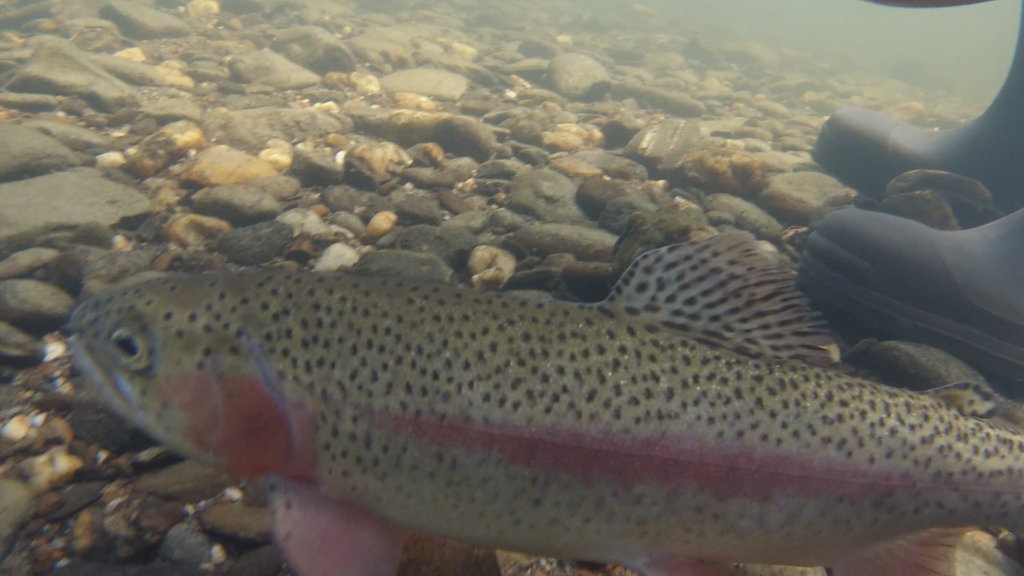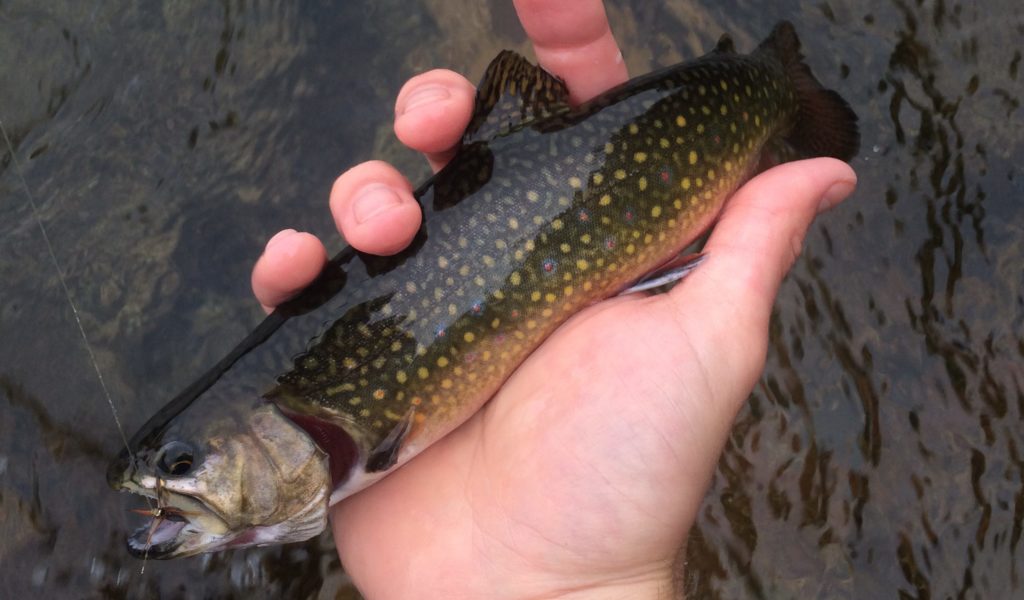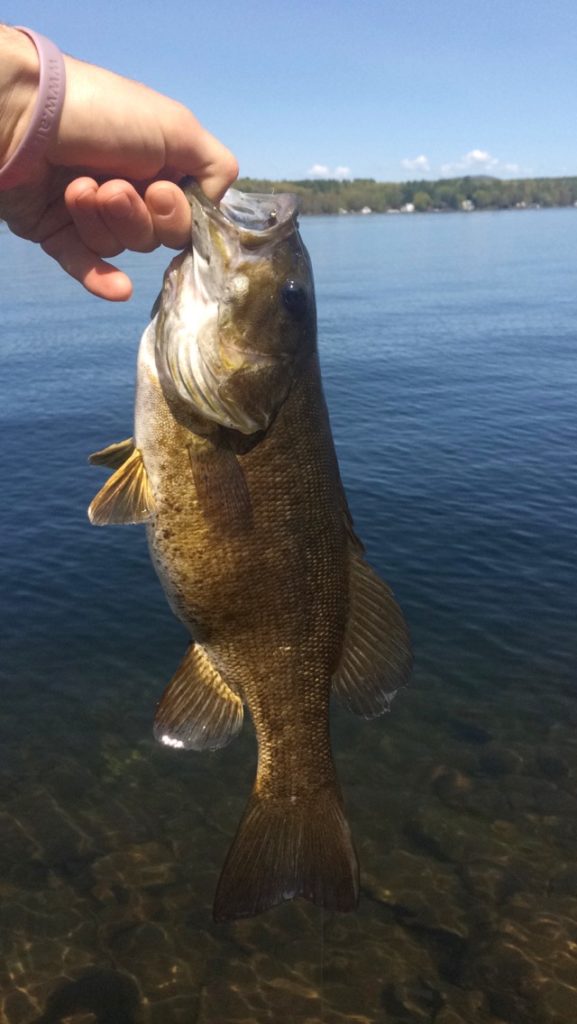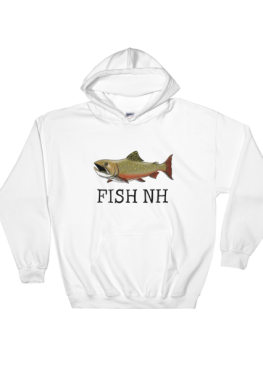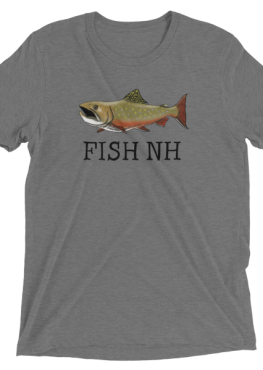New Hampshire may not be known for best fly fishing in the country, but that doesn’t mean there isn’t great fishing all around the state. With miles of ocean front, numerous estuaries, hundreds of rivers, lakes, and beautiful mountains; NH offers a wide range of fishing options and some of the best scenery in the country. This post will give you an overview of fishing in New Hampshire and also provide links to relevant resources.
Article Quick Navigation:
Fishing Seasons
Where to Fish
Flies
Guides
Types of Fish
What are the NH fishing seasons? Take a look here:
For Brook Trout, Rainbow Trout, Brown Trout & Hybrids:
| Area | Season |
|---|---|
| Rivers & Streams | January 1 – October 15 |
| Wild Trout Streams | January 1 – Labor Day |
| Trout Ponds | 4th Saturday in April – October 15 |
| Wild Trout Ponds | 4th Saturday in April – Labor Day |
| Lake Trout and/or Salmon Waters | January 1 – September 30 (fish can be taken by ice fishing only January 1 – March 31) |
| All Other Waters | No closed season |
For Lake Trout
| Area | Season |
|---|---|
| All Waters | January 1 – September 30 (Fish can be taken by ice fishing only January 1 – March 31) |
For Landlocked Salmon
| Area | Season |
|---|---|
| Pleasant Lake, New London | 4th Saturday in April – September 30 |
| All Other Waters | April 1 – September 30 |
For Largemouth Bass & Smallmouth Bass
| Area | Season |
|---|---|
| Rivers & Streams | January 1 – October 15; Catch & Release May 15 – June 15 |
| Trout Ponds | 4th Saturday in April – October 15; Catch & Release May 15 – June 15 |
| Lake Trout and/or Salmon Waters | No closed season (Fish can be taken by ice fishing only January 1 – March 31) |
| All Other Waters | No closed season; Catch & Release May 15 – June 15 |
NH Stocking Reports? Take a look here
If you want fishing regulartions, size limits and catch limits, you should check here: http://www.eregulations.com/newhampshire/fishing/freshwater/rivers-streams-general-special-rules/
Where are the best places to fish in New Hampshire?
New Hampshire has thousands of fishable rivers and lakes. We have highlighted some of the most well known below. We also encourage you to check out the fly fishing only sections in the state. Each of the rivers we mention includes a full guide with a map of fishing locations on each river.
The Big Rivers
Some of the best experiences are found on the big rivers of NH. From the Pemigewasset to the Androscoggin to the Connecticut and others. These rivers offer an extremely diverse marine habitat. From salmon and other androgynous fish species, to Pike to trout and bass.
The Connecticut River
The trophy stretch (as many call it) of the Connecticut river offers some of the most fun fly fishing in New England. Some of the state’s best fish are pulled out of the river and safely released back in. The Connecticut lakes and the smaller rivers flowing into the Connecticut are all great options. Some large dams change the flow of water drastically, and boats are often launched, offering a significantly different fishing experience depending on season and water flow. Some of the best Pike fishing can be found in the northern parts of the Connecticut as well.
Another incredible angling experience available on the Connecticut River is Pike fishing. These fish are big, strong, and incredible hunting machines. While not easy to hook up with on the fly, there are expert guides that can get you on some incredible fish. If you like tossing big streamers, and enjoy hard fights, this is a great option.
Check out our complete guide to fishing the upper Connecticut River.
The Pemigewasset River (Pemi) – Which turns into the Merrimack
Anglers can hit the headwaters in Franconia Notch by Echo and Profile lake, and follow the river all the way to the lakes region where it becomes the Merrimack river. Up north, the trout fishing is fantastic, with tons of brookies, rainbows and brown trout. The river quickly gets much larger, especially in Lincoln where the east branch and lost river converge and flow into the Pemi. Though the river is much larger, there is still an array of fast water, slow water, and all sorts of fishing options. It is easy to find substantial stretches of river where you will be fishing alone. Interstate 93 parallels the river for many miles, making access quite easy.
Because the Pemi river is so long, and offers so much water to fish, it is difficult to point out some of the best areas.
If anglers want to target native trout, the upper stretches of the Pemi, north of Lincoln are your best bet. If you enjoy pond fishing, the headwaters of Profile like and Echo Lake are very productive. If you like smaller pocket water, the river immediately flowing out of these lakes until Lincoln is fantastic. The East Branch of the Pemi, which flows through Lincoln is a fantastic option to target smaller and native brook trout.
The stretches of river from Lincoln to Plymouth offer anglers the ability to catch some pretty large fish. During summer months, you will however find many tubers, swimmers, families, and spin rod fisherman on the shorelines. Big browns, rainbows and brookies are pulled out of these stretches frequently. Given the pressure on this river, please practice catch and release with barbless hooks.
Southern stretches offer carp, bass and other warm water species that are sought out by many anglers.
The Androscoggin River
This fast flowing water in northern NH is absolutely stunningly beautiful at every bend in the river. With a variety of wild fish, stocked fish, and even salmon, this river is home to some of my best experiences fishing. The fast water can make it extremely difficult in areas, but of course you can also find slower waters. In my opinion, the Androscoggin offers some of the best fishing in the state. Many anglers choose canoes, kayaks and drift boats. Some monster fish come out of here too…quite frequently. This river has fly fishing only sections.
Check out our complete guide to fishing the upper Androscoggin River.
The Saco
The Saco begins in Crawford Notch at Saco lake, a small stocked pond nestled between some gorgeous peaks. You will often see fly fishers nailing brookies on dry flies here. Don’t be fooled, the entire stretch of river flowing through NH offers some amazing and beautiful fishing as well. With fast rapidly moving water in the notch, fly fishing can be exciting, but farther down many choose to use drift boats. The water is often extremely clear, with flat sand bottom, allowing for sight fishing. The Saco also has fly fishing only sections.
Check out our complete guide to fishing the Saco River.
Brown Trout from Saco River
The Swift
The Swift river is an incredibly beautiful and highly trafficked river along the famous Kancamagus highway. There are miles and miles of water holding fish, with easy access from the road. Here you can find some really great native trout. A map wouldn’t do you any good here as you can fish pretty much any section of this entire river along the Kanc. This section is filled with gorgeous pocket water sections.
White Mountain Streams
Fishing the White Mountain Streams for native brookies is just too fun and too beautiful. The native trout may often be very small, but they are stunning, and can provide a full day of awesome fishing. Get your smallest weight rod and get out there. Be respectful, leave no trace, use no barbs, and release all fish. Leave the fish alone if the water temps get too high.
There are also countless other rivers across the state with a thriving population of fish. Many of which are stocked in various seasons. Some of the common rivers in the southeast region are the Lamprey River, the Cocheco River, the Isinglass River. Central New Hampshire has the Merrymeeting River, Winnipesaukee River, Newfound River and countless others.
The Ocean and Estuaries
Stripers, Steelhead, Salmon, Salty Browns!? Yes to all and more. There are some avid fly fisherman that hone in on these species during the right months of the year. All can be extremely difficult to target, but find the right person, and you’ll see them be continuously successful out there.
The Big Lakes
Central and northern NH offer extremely versatile and beautiful fishing experiences. From the largest, Lake Winnipesaukee, to the smaller bigger lakes like Newfound, Umbagog, First Connecticut and Lake Francis, there is incredible fishing to be had. The bigger lakes of New Hampshire offer nearly every species that can be caught in NH. These lakes are often sought out for their landlocked Salmon, Lake Trout and also their warm water species. Though not all of the larger lakes have all of the species, they are some the most diverse bodies of water in the state.
Many fisherman elect to troll for salmon, rainbow trout and lake trout during summer months. In the winter, ice fishing takes over with numerous fishing derbies that bring in 10+ and sometimes 15+ pound lake trout. Cusk get very large as well.
Though these large lakes offer tons of quality fishing, they are not best suited for fly fishing, but for other angling methods. Interested in ice fishing? Check out our post: Ice Fishing Lake Winnipesaukee.
The Little Lakes and Ponds
With designated trout ponds that offer endless hookups, other bodies of water with huge populations of bass, crappie, pickerel and more, there is fun for all types of anglers. From fly fishing the still pond waters, or the rivers that flow in and out of the bodies of water, to trolling and ice fishing. New Hampshire’s ponds offer some of the most fun fishing around. Various bodies of water offer different fishing seasons dependent on the species within the lake, but many of these lakes and ponds are open for fishing year round. Some of the most iconic fly fishing lakes include Profile lake and Echo lake in Franconia notch.
Guides
Below is a list of a large portion of the fly fishing guides in New Hampshire organized by region. If you are looking for a fly fishing guide, check out our guided fishing page, and we will hook you up!
Northern NH
- Cabins at Lopstick in Pittsburg, NH. Visit website here: https://www.lopstick.com/experiences/the-fly-fishing-experience/
- Tall Timber Lodge in Pittsburg, NH. Visit website here: http://www.talltimber.com/
- Osprey Fishing Adventures in Colebrook, NH. Visit website here: http://www.ospreyfishingadventures.com/
- Dan’s Fly Shop and Guide Service in Gorham, NH. Visit website here: http://dansflyshop.net/
Central NH
- Mountain High Fly in Lincoln, NH. Visit website here: https://www.mountainhighfly.com/
- North Country Angler in North Conway, NH. Visit website here: http://www.northcountryangler.com/
- Shoals Fly Fishing and Light Tackle in Portsmouth, NH. Visit website here: http://www.shoalsflyfishing.com/
- Stone River Outfitters in Bedford, NH. Visit website here: http://www.stoneriveroutfitters.com/
- Seacoast Fly Fishing in Dover, NH. Visit website here: http://www.seacoastflyfishing.com/
Recommended Flies in New Hampshire
It is difficult to recommend flies that will suit all of the rivers in New Hampshire in every season. Through experience, there are a few flies that seem to always be successful in nearly every season, pond, or river in New Hampshire.
- Copper Johns – Pretty much any color works well. Size 14 seems to be the most versatile. This is a go to fly when you have to get deep, or are in fast moving water. Works year round.
- Pheasant Tail Nymphs – Again, this fly works almost everywhere in any season. If a copper john isn’t working, a pheasant tail nymph probably will. Get good drifts, and get it down.
- Wooly Buggers – An all season fly, when no fish seems to be biting, pulling out a streamer rig with an olive or white wooly bugger is an awesome choice. Sometimes you can coax a larger fish to move a little more than they would for a nymph. Try all types of techniques, dead drifting, stripping down stream and swinging.
- Elk Hair Caddis – this is one of the best all around dry flies. Never go to the river without the above nymphs and streamers though.
- Zebra Midge – In winter, small midges perform great. Size 18-20.
New Hampshire Fish: What kinds of fish can you expect catching?
All of these with Wikipedia Definitions and links…and some more too:
Brook Trout
- Brook Trout (Salvelinus fontinalis) are native to New Hampshire. They are in the salmon family Salmonidae. It is native to Eastern North America in the United States and Canada, but has been introduced elsewhere in North America and to other continents. In parts of its range, it is also known as the eastern brook trout, speckled trout, brook charr, squaretail, or mud trout, among others. A potamodromous population in Lake Superior is known as coaster trout or, simply, as coasters. The brook trout is the state fish of nine states: Michigan, New Hampshire, New Jersey, New York, North Carolina, Pennsylvania, Vermont, Virginia, and West Virginia, and the Provincial Fish of Nova Scotia in Canada.
Rainbow Trout
- The rainbow trout (Oncorhynchus mykiss) is a trout and species of salmonid native to cold-water tributaries of the Pacific Ocean in Asia and North America. The steelhead (sometimes called “steelhead trout”) is an anadromous (sea-run) form of the coastal rainbow trout (O. m. irideus) or Columbia River redband trout (O. m. gairdneri) that usually returns to fresh water to spawn after living two to three years in the ocean. Freshwater forms that have been introduced into the Great Lakes and migrate into tributaries to spawn are also called steelhead.
Brown Trout
- The brown trout (Salmo trutta) is a European species of salmonid fish that has been widely introduced into suitable environments globally. It includes both purely freshwater populations, referred to as the riverine ecotype or Salmo trutta morpha fario and a lacustrine ecotype, S. trutta morpha lacustris, as well as anadromous forms known as the sea trout, S. trutta morpha trutta. The latter migrates to the oceans for much of its life and returns to fresh water only to spawn. Sea trout in the UK and Ireland have many regional names, including sewin (Wales), finnock (Scotland), peal (West Country), mort (North West England), and white trout (Ireland).
Lake Trout
- Lake trout (Salvelinus namaycush) is a freshwater char living mainly in lakes in northern North America. Other names for it include mackinaw, lake char (or charr), touladi, togue, and grey trout. In Lake Superior, it can also be variously known as siscowet, paperbelly and lean. The lake trout is prized both as a game fish and as a food fish.
Salmon
- Salmon /ˈsæmən/ is the common name for several species of ray-finned fish in the family Salmonidae. Other fish in the same family include trout, char, grayling and whitefish. Salmon are native to tributaries of the North Atlantic (genus Salmo) and Pacific Ocean (genus Oncorhynchus). Many species of salmon have been introduced into non-native environments such as the Great Lakes of North America and Patagonia in South America. Salmon are intensively farmed in many parts of the world.
Small and Largemouth Bass
- Bass (/ˈbæs/ bass) is a name shared by many species of fish. The term encompasses both freshwater and marine species, all belonging to the large order Perciformes, or perch-like fishes. The word bass comes from Middle English bars, meaning “perch”.
Pike
- The northern pike (Esox lucius), known simply as a pike in Britain, Ireland, most of Canada, and most parts of the United States (once called luce when fully grown; also called jackfish or simply “northern” in the U.S. Upper Midwest and in Manitoba), is a species of carnivorous fish of the genus Esox (the pikes). They are typical of brackish and fresh waters of the Northern Hemisphere (i.e. holarctic in distribution).
Sunfish
- The sunfish are a family (Centrarchidae) of freshwater ray-finned fish belonging to the order Perciformes. The type genus is Centrarchus (consisting solely of the flier, C. macropterus). The family’s 37 species include many fish familiar to North Americans, including the rock bass, largemouth bass, bluegill, pumpkinseed, and crappies. All are native only to North America.
Suckers
- The white sucker (Catostomus commersonii) is a freshwater Cypriniform fish inhabiting the upper Midwest and Northeast in North America, but is also found as far south as Georgia and New Mexico in the south and west. The fish is commonly known as a “sucker” due to its fleshy papillose lips that suck up organic matter and aufwuchs from the bottom of rivers and streams.
Carp
- Carp are made up of various species of freshwater fish from the family Cyprinidae, a very large group of fish native to Europe and Asia.
In addition to the above, you’ll find perch, crappie, and many other species in New Hampshire.
NH Fishing License
Licenses can be picked up at various locations across the state. Many sporting goods stores, smaller country stores and Walmarts sell licenses. The easiest way to get your license is online. Here is a link to get you NH Fishing License
Ocean Fishing in NH
Many anglers absolutely love fishing for Stripers. As the warmer months roll in, so do the stripers, supplying anglers with some of the best fighting, and fun to target fish out there. Though NH only has a small amount of shoreline, anglers flock to the coast. Purchasing the $11 ocean fishing license has reciprocity in both Maine and Massachusetts.
Fly fishing for stripers has become increasingly popular and is possible from shoreline, bridges, boats and docks.
Interested in striped bass hotspots from an expert? Check out this PDF from NH Fish and game.
We also have a great post, fly fishing for beginners, that should help cover everything you need to know if you are new to fly fishing.
Max DesMarais is the founder of hikingandfishing.com. He has a passion for the outdoors and making outdoor education and adventure more accessible. Max is a published author for various outdoor adventure, travel, and marketing websites. He is an experienced hiker, backpacker, fly fisherman, backcountry skier, trail runner, and spends his free time in the outdoors. These adventures allow him to test gear, learn new skills, and experience new places so that he can educate others. Max grew up hiking all around New Hampshire and New England. He became obsessed with the New Hampshire mountains, and the NH 48, where he guided hikes and trail runs in the White Mountains. Since moving out west, Max has continued climbed all of the Colorado 14ers, is always testing gear, learning skills, gaining experience, and building his endurance for outdoor sports. You can read more about his experience here: hikingandfishing/about

